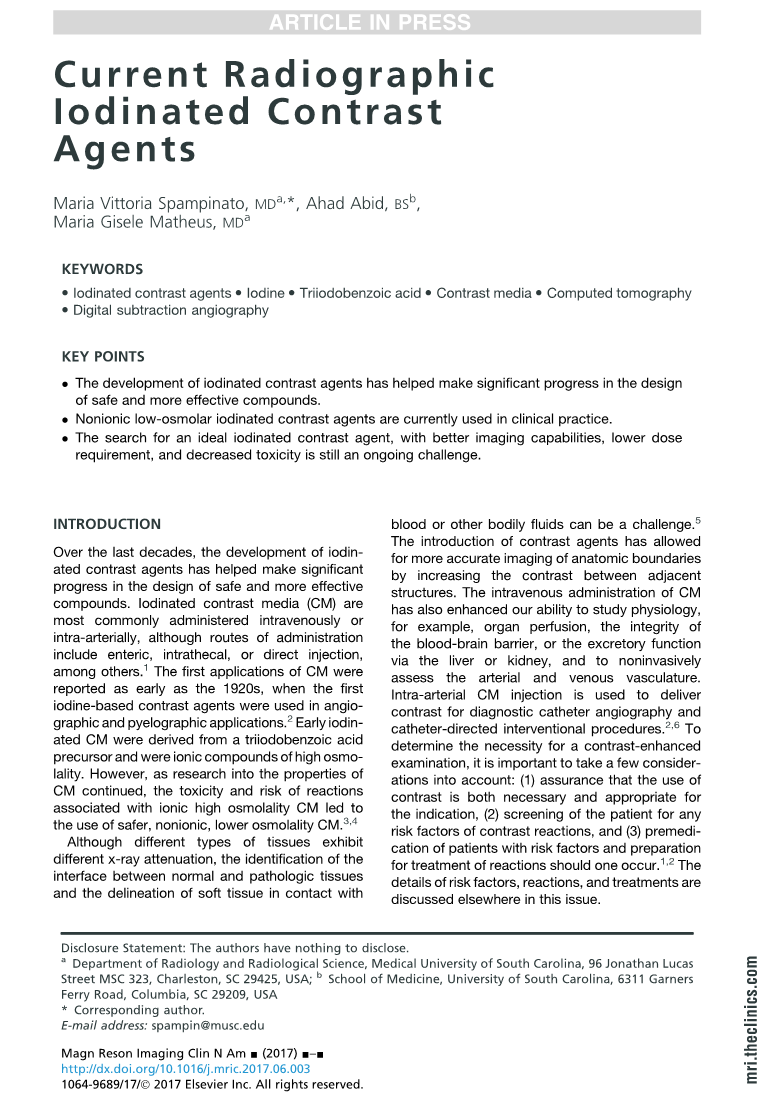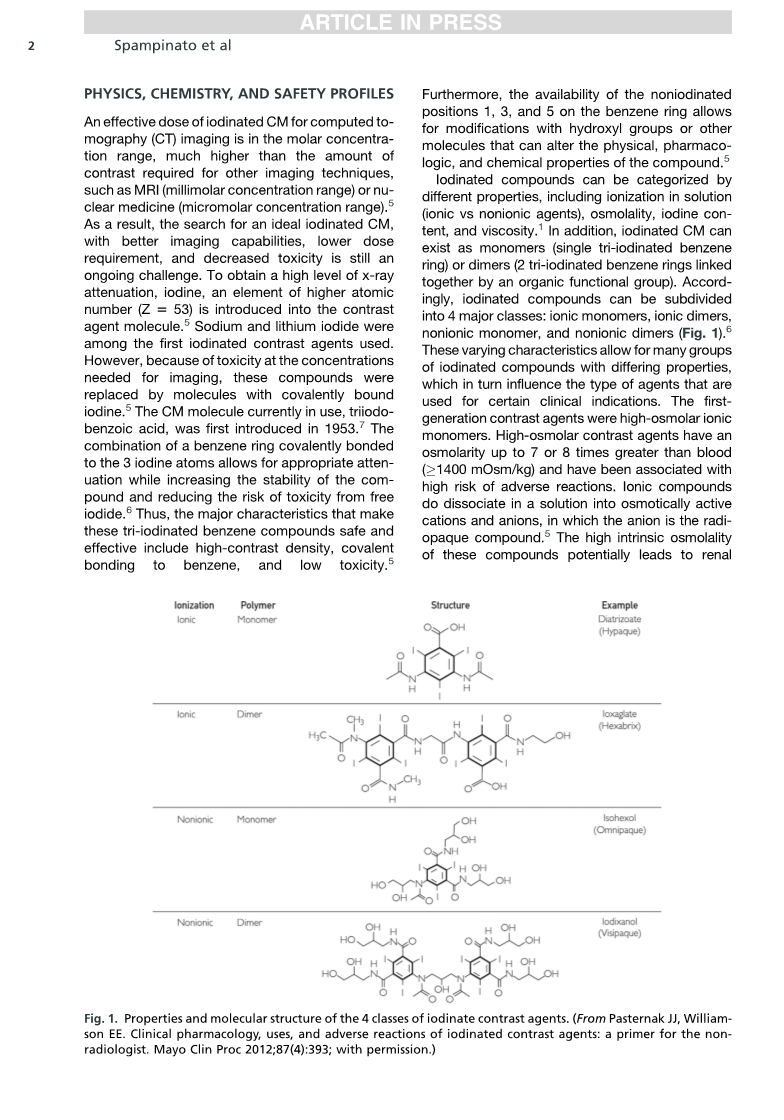

英语原文共 8 页,剩余内容已隐藏,支付完成后下载完整资料
Current Radiographic Iodinated Contrast Agents
放射性碘造影剂的现状
KEYWORDS
·Iodinated contrast agents · Iodine · Triiodobenzoic acid · Contrast media Computed tomography
·Digital subtraction angiography
关键词
·碘化造影剂 ·碘 ·三碘苯甲酸 ·造影剂 ·计算机断层扫描
·数字减影血管造影
KEY POINTS
·The development of iodinated contrast agents has helped make significant progress in the design of safe and more effective compounds.
·Nonionic low-osmolar iodinated contrast agents are currently used in clinical practice.
·The search for an ideal iodinated contrast agent, with better imaging capabilities, lower dose requirement, and decreased toxicity is still an ongoing challenge.
关键点
·碘化造影剂的发展有助于使设计更安全和有效的化合物方面取得重大进展。
·非离子型低渗碘化造影剂是目前临床使用的造影剂。
·寻找理想,具备更好的效果、更低剂量,更低毒性的造影剂,仍然是一个持续的挑战。
INTRODUCTION引言
Over the last decades, the development of iodinated contrast agents has helped make significant progress in the design of safe and more effective compounds. Iodinated contrast media (CM) are most commonly administered intravenously or
intra-arterially, although routes of administration include enteric, intrathecal, or direct injection,among others.1 The first applications of CM were reported as early as the 1920s, when the first iodine-based contrast agents were used in angiographic and pyelographic applications.2 Early iodinated CM were derived from a triiodobenzoic acid precursor and were ionic compounds of high osmolality. However, as research into the properties of CM continued, the toxicity and risk of reactions associated with ionic high osmolality CM led to the use of safer, nonionic, lower osmolality CM.3,4
在过去的几十年里,碘化造影剂的发展已经帮助设计安全有效的化合物的方面取得重大进展。尽管碘造影剂(CM)的给药途径包括肠内、鞘内和直接注射等,但它最常用于静脉或动脉内给药。1 CM的首次应用早在20世纪20年代就有报道,当时第一批碘基造影剂被应用于血管造影和肾盂造影。2早期的碘化CM是由三碘苯甲酸前体衍生而来,是高渗透性的离子化合物。然而,随着对CM性质的研究不断深入,与离子型高渗压CM相关的毒性和反应风险使得更安全、非离子型、低渗压的CM被应用。3,4
Although different types of tissues exhibit different x-ray attenuation, the identification of the interface between normal and pathologic tissues and the delineation of soft tissue in contact with blood or other bodily fluids can be a challenge.5 The introduction of contrast agents has allowed for more accurate imaging of anatomic boundaries by increasing the contrast between adjacent structures. The intravenous administration of CM has also enhanced our ability to study physiology,for example, organ perfusion, the integrity of the blood-brain barrier, or the excretory function via the liver or kidney, and to noninvasively assess the arterial and venous vasculature.Intra-arterial CM injection is used to deliver contrast for diagnostic catheter angiography and catheter-directed interventional procedures.2,6 To determine the necessity for a contrast-enhanced examination, it is important to take a few considerations into account: (1) assurance that the use of contrast is both necessary and appropriate for the indication, (2) screening of the patient for any risk factors of contrast reactions, and (3) premedication of patients with risk factors and preparation for treatment of reactions should one occur.1,2 The
details of risk factors, reactions, and treatments are discussed elsewhere in this issue.
尽管不同类型的组织表现出不同的x射线衰减,但是识别正常组织和病理组织之间的界面以及描绘与血液或其他体液接触的软组织仍然是一个挑战。5造影剂的引入通过增加相邻结构之间的对比度,使得解剖边界的成像更加精确。静脉注射CM也增强了我们研究生理学的能力,例如器官灌注,血脑屏障的完整性,通过肝脏或肾脏的排泄功能,无创性评估动脉和静脉脉管系统等。动脉CM注射被用来提供用于诊断性导管血管造影和导管引导的介入治疗的造影剂。2,6为了确定对比增强检查的必要性,必须考虑以下几点:(1) 保证造影剂的使用是必要的且适合于症状,(2)筛查患者是否有任何造影剂过敏应的危险因素,以及(3)对有危险因素的患者进行预处理,并为治疗中的可能发生的反应做好准备。1,2风险因素、反应和治疗的细节将在本期的其他部分讨论。
PHYSICS, CHEMISTRY, AND SAFETY PROFILES物理,化学,和安全概况
An effective dose of iodinated CM for computed tomography (CT) imaging is in the molar concentration range, much higher than the amount of contrast required for other imaging techniques,such as MRI (millimolar concentration range) or nuclear medicine (micromolar concentration range).5As a result, the search for an ideal iodinated CM,with better imaging capabilities, lower dose requirement, and decreased toxicity is still an ongoing challenge. To obtain a high level of x-ray attenuation, iodine, an element of higher atomic number (Z 5 53) is introduced into the contrast agent molecule.5 Sodium and lithium iodide were among the first iodinated contrast agents used.However, because of toxicity at the concentrations needed for imaging, these compounds were replaced by molecules with covalently bound iodine.5 The CM molecule currently in use, triiodobenzoic acid, was first introduced in 1953.7 The combination of a benzene ring covalently bonded to the 3 iodine atoms allows for appropriate attenuation while increasing the stability of the compound and reducing the risk of toxicity from free iodide.6 Thus, the major characteristics that make these tri-iodinated benzene compounds safe and effective include high-contrast density, covalent bonding to benzene, and low toxicity.5Furthermore, the availability of the noniodinated positions 1, 3, and 5 on the benzene ring allows for modifications with hydroxyl groups or other molecules that can alter the physical, pharmac-logic, and chemical properties of the compound.5
用于计算机断层扫描(CT)成像的碘化CM的有效剂量,在摩尔浓度范围内,远高于其他成像技术所需的造影剂的剂量,例如MRI(毫摩尔浓度范围)或核医学(微摩尔浓度范围)。5因此,寻找一种理想的,具有更好的成像能力、更低的剂量要求和更低的毒性的碘代CM仍然是一个持续的挑战。为了获得高水平的x射线衰减,在造影剂分子中引入原子序数较高的碘元素(z=53)。5碘化钠和碘化锂是最早使用的碘化造影剂,但是,因为成像所需浓度的毒性,这些化合物被共价结合碘的分子所取代。目前使用的CM分子,三碘苯甲酸,于1953年首次引入,7苯环与3个碘原子共价结合,可适当衰减,同时增加化合物的稳定性,降低游离碘的毒性风险。6因此,使这些三碘苯化合物安全有效的主要特征是高对比度、与苯共价键合和低毒性。5此外,苯环上非碘化位置1、3和5可用羟基或其他分子进行修饰,从而改变化合物的物理、药理和化学性质。lt;
剩余内容已隐藏,支付完成后下载完整资料
资料编号:[257542],资料为PDF文档或Word文档,PDF文档可免费转换为Word
您可能感兴趣的文章
- 下游产品是硫酸乙酰肝素2-0-磺基转移酶的有效抑制剂外文翻译资料
- 奥希替尼的耐药性不断发展的格局外文翻译资料
- 伪五山淫羊隆区域特异性鼠李糖基转移酶催化丙烯醇的3-阿霉素酰化 反应外文翻译资料
- 标记化合物和放射性药物杂志外文翻译资料
- 脂肪酶大规模分离水飞蓟宾非对映异构体外文翻译资料
- 钯催化萘胺与二芳基二硫化物和二硒醚的 C-H键裂解近选择性加成反应外文翻译资料
- 铜催化,定向基团辅助氟化芳烃和异芳烃碳氢键外文翻译资料
- Talin1通过局灶性粘附信号和失巢凋亡抵抗促进肿瘤侵袭和转移。外文翻译资料
- 杜氏肌营养不良综合征中的外显子跳跃外文翻译资料
- 来源于红树林内生菌稀有的细菌产caryolanes类代谢产物Bacaryolanes A−C外文翻译资料


